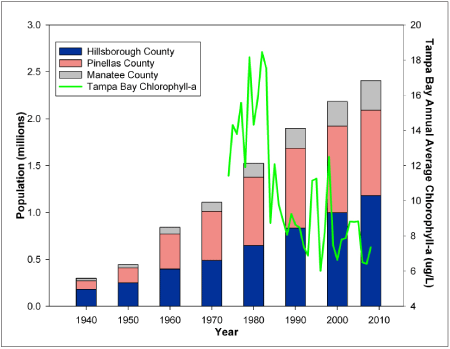 |
||||||||
Tampa Bay Consortium Reaches Landmark Agreement
 Even as federally mandated numeric nutrient criteria continue to dominate headlines, the Florida Department of Environmental Protection has approved a landmark agreement adopting a process developed by the Tampa Bay Nitrogen Management Consortium to support the continued recovery of Tampa Bay’s water quality and underwater seagrass.
Even as federally mandated numeric nutrient criteria continue to dominate headlines, the Florida Department of Environmental Protection has approved a landmark agreement adopting a process developed by the Tampa Bay Nitrogen Management Consortium to support the continued recovery of Tampa Bay’s water quality and underwater seagrass.
“This is the first time in the U.S. where a local group of public and private partners has defined nitrogen allocations, proposed them to the DEP and had them accepted,” notes Holly Greening, executive director of the Tampa Bay Estuary Program. “The effort included a big group covering a big area – more than 40 local governments and industries across the entire 2,400 square mile watershed – with nitrogen load allocations developed in a collaborative process.”
The consortium, established by the TBEP in 1996, includes representatives of every major government in the Tampa Bay watershed, as well as well as key industries such as utilities, fertilizer manufacturers and commercial agriculture.
The agreement limits nitrogen inputs to the bay to 2003-2007 levels, which is consistent with the target initially identified by TBEP to allow the regrowth of seagrasses in areas where they were found in 1950. Over the past 15 years, more than 250 projects by consortium members have reduced nitrogen flowing into the bay by more than 500 tons, even as the region’s population grew by more than a million people.
While nutrients are necessary for all forms of life, in excess they cause algal blooms that block light necessary for seagrass growth and deplete oxygen needed by fish and shellfish. In Tampa Bay, nutrients come from urban, agricultural and natural stormwater runoff, atmospheric deposition, groundwater, municipal wastewater treatment plants, and industrial discharges.
Although Tampa Bay governments and industry have been working together voluntarily since 1996 to limit nitrogen inputs, this is the first time the effort has been approved by regulatory agencies, Greening said. The nitrogen loading allocations now meet the Total Maximum Daily Loads (TMDLs) for Tampa Bay nitrogen loading set by the federal government in 1998.
The consortium’s success is clear. Since 1995, Tampa Bay has met annual water quality thresholds more than 85% of the time and seagrass coverage has expanded by more than 10%. “The most telling story is that, with the exception of years with very heavy rainfall and in Old Tampa Bay (see story on page 1), Tampa Bay is meeting water quality requirements to support seagrass recovery,” Greening said.
Facing the Future
But even with proven accomplishments, Tampa Bay managers still face tough decisions. No one knows what the new federal standards will be when the EPA releases its estuarine numeric nutrient criteria in August 2012. Governments and industry also must compensate for additional nitrogen loading working within new allocations that limit discharges to current levels.
Across the board, many bay managers are still not aware of the implications for land use planning, notes Suzanne Cooper, principal planner for the Tampa Bay Regional Planning Council, which is working for the TBEP on a two-year project to inform local government planning departments, business and development groups and other parties about new regulatory requirements.
Capping nitrogen loads at existing levels has broad implications for both business and the local governments who oversee nitrogen loadings from sources as diverse as wastewater treatment plants to new developments.
“In the past a wastewater treatment facility might have a permit for much higher loadings than it actually used,” Cooper said. “Now they will be held to actual loads so if the facility needs to expand and go over that permitted allocation, they’ll have to cut back their nitrogen loading somewhere else.”
From a land-use perspective, cities and counties also must limit new nitrogen inputs by restricting new development from causing increased loads or retrofitting older neighbors and stormwater facilities to capture more nutrients.
“One of the first tasks will be identifying the best way to reach out to the diverse audience and then looking at optimum ways to engage them,” Cooper said. Part of the effort also is likely to include data on how reducing nitrogen affects the natural resources in Tampa Bay as well as reviews of cost-effective techniques for removing nutrients.
